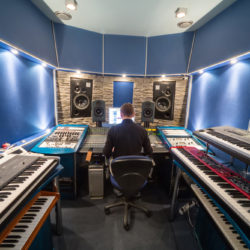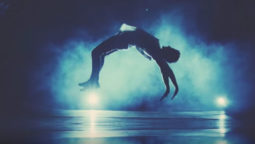I Wanna Be A DJ! Equipment Essentials: Monitors
In case you’ve been living under a rock for the past few years, DJs are now the new rock stars. The DJ industry has seeped into every aspect of pop culture, and now learning to become a DJ has become what becoming a rock guitarist was in the 80’s. From TV advertisements to reality shows, DJing has clawed its way into the mainstream and is here to stay.
Because of the rising popularity in EDM, the numbers of people wanting to learn the secret art-of-making-booties-shake is also on the rise. From beatmatching (synchronizing different BPMs) to mixing (because when you just hit stop on one track and play on another, it’s called Paris Hiltoning), there is quite a lot to learn about this craft. But most importantly, getting the right gear can save you a good deal of time and money.
Over six weeks, we’ll take a tour through the business, checking out all the major players in the DJ gear industry today. We’ll be providing a comprehensive review of the major categories, from headphones to MIDI controllers. We will cover it all so you can make the most informed decision kitting out your DJ arsenal.
Catching up:
Week 1: All-In-One-Controllers
Week 2: DJ Software
Week 3: Media Players
Week 4: Headphones
And now, onto this week’s edition…
Week 5: Monitors
These days there are many choices when it comes to speakers. From basic home setups, to elaborate concert line arrays, there has been a great deal of research done on how to deliver the best audio experience possible. This is especially true in the arenas of DJing and audio production. Whether it is in the club, or the studio, having clear audio playback is a must, and picking the right speaker for each application can be confusing. This week we will be covering monitors: the different types and applications they can be used for.
Studio Monitors
When I first started DJing, I thought of studio monitors as an elite type of speaker which didn’t apply to my use. After playing  for years on a JBL EON PA monitor, one day I went to a friend’s house and played a set on his Mackie HR 824 studio monitors. I was blown away at the clarity that the studio monitors had. That clarity allowed me to fine tune my mixes in a way I never could on a standard monitor, which helped my beat matching, and EQing skills immensely.
for years on a JBL EON PA monitor, one day I went to a friend’s house and played a set on his Mackie HR 824 studio monitors. I was blown away at the clarity that the studio monitors had. That clarity allowed me to fine tune my mixes in a way I never could on a standard monitor, which helped my beat matching, and EQing skills immensely.
One reason I really loved the Mackie HR 824 monitors was because of the low-end frequency response: the-oh-so-important bass, because with out bass, you’ve got new age synth music. The monitor really had a lot of bass punch and was very appealing for my use case [i.e. what you’re using the speakers for]. Knowing your use case for your speakers is VERY important. The great boost in the lower frequencies were the very reason I loved the Mackie HR 824 monitor, but that same feature is not attractive to an audio engineer who wants a monitor that has a very flat frequency response.
 I had the opportunity to practice a DJ set on a pair of Genelec 1032B studio monitors. For a DJ set, I felt the low end was lacking and the speakers sounded a little flat, these monitors initially turned me off. Years later after learning a great deal about audio engineering, I found that these speakers are ideal for mix engineering and mastering. Now, I prefer to have a speaker like this in my studio versus one that has an artificial frequency response. Once again, knowing the application in which your speakers are to be used for is very important.
I had the opportunity to practice a DJ set on a pair of Genelec 1032B studio monitors. For a DJ set, I felt the low end was lacking and the speakers sounded a little flat, these monitors initially turned me off. Years later after learning a great deal about audio engineering, I found that these speakers are ideal for mix engineering and mastering. Now, I prefer to have a speaker like this in my studio versus one that has an artificial frequency response. Once again, knowing the application in which your speakers are to be used for is very important.
Lastly, with studio monitors it is very important to position them correctly. Most studio monitors are intended to be used in close proximity to your head, and sound differently depending on the configuration of the room. This article from Sound On Sound, can assist you with the details of setting up your studio monitors.
PA Monitors
PA speakers are what you would normally see at a DJ gig. Setups can range from a few standard monitors to an elaborate setup featuring chained subwoofers using crossovers and DSP. Because of portability, most travelling DJs use powered speaker setups. Powered speakers give you the ability to carry around a great deal of power with a small footprint.
Like I stated earlier, the first PA monitor I used was a JBL EON. I initially loved the EON because of how loud the speaker got. The monitor also gave me a great deal of power, which made it perfect for house party situations. Soon after using the EON, I started seeing a speaker over and over at my gigs. This speaker was very distinct because it had a bright blue LED light on the front of it. I later found out that this speaker was the Mackie SRM-450 and would eventually be one of the highest selling PA monitors of all time.
The reason the Mackie SRM-450 was high selling was it’s great amount of power, high quality sound and great portability. All of the features found in the SRM-450 set the standard for what to expect on a PA monitor and now can be found on all sorts of models today. Whether it be the QSC K Series or the JBL EON 500 Series, you will find a great deal of power with on board DSP which allows you to tune the sound the venue you are using it in. Using a PA monitor, you wont get the definition you would with a studio monitor, but you will get a louder sound that will easily power a nice sized party.
In addition to monitors, you can also get subwoofers to bring more low-end to your setup. If you plan to add a subwoofer to your existing setup, I would recommend getting a matching subwoofer to the setup you already have. For example, if you have the Mackie SRM-450, I would recommend using an SRM-1850 to accompany it. Additionally, some subwoofer setups come with speaker pole mounts to allow a PA monitor to sit on top of it.
As always, thanks for reading, please share with your friends, and check back next week for our final installment of I Wanna Be a DJ!
©2013MWFC






Join the discussion
comments powered by Disqus